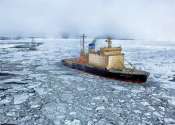Convergence science in the changing Arctic
The Arctic is undergoing rapid changes that affect its natural environment, its people, and its role in global-scale natural processes. The interplay of climate change, industrialization, and other stressors makes the Arctic ...









